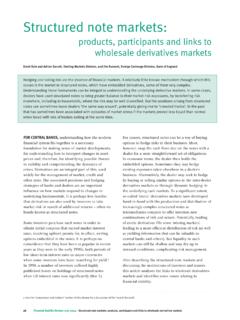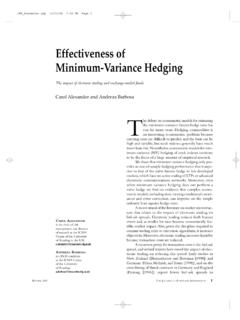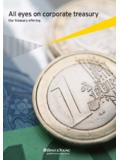Transcription of Hedging and Risk Management - Giddy
1 Giddy | Hedging1Dr. Ian GiddyNew York UniversityHedgingand Risk Management3 Copyright 2009 Ian H GiddyOutline of the SeminarOutline of the Seminar objectives of Hedging Types of Exposure and Hedging Hedging Techniques Risk ControlGiddy | Hedging24 Copyright 2009 Ian H GiddyObjectives of HedgingObjectives of Hedging What risks are hedgable? Business risk versus market price risk Hedging in the current market crisis Should companies and banks hedge? Hedging based on the theory that market movements are unpredictable Advantages and disadvantages of "selective Hedging " How much to hedge? 0%-50%-100% Value creation through risk reduction5 Copyright 2009 Ian H GiddyBusiness Risk versus Market RiskBusiness Risk versus Market Risk Types of business risk: Demand for product Cost of production Others, such as earthquake insurable Types of market price risk: Currencies Interest rates Commodity prices Companies and banks should managetheir business risks , and hedgetheir market risks (if possible).
2 Giddy | Hedging36 Copyright 2009 Ian H GiddyBusiness Risk Should be Business Risk Should be ManagedManaged 2006, February: Linens n Things bought by Apollo for $ billion, with $1 billion of debt 2008, May: Linens files for bankruptcy. What went wrong?7 Copyright 2009 Ian H GiddyMarket Risk Should be Market Risk Should be HedgedHedged 2008, January: A Russian upscale supermarket chain, AV, borrows USD 50 million from the EBRD 2009, February: Russian rouble falls, AV unable to service its debt What went wrong?Source: RoubleGiddy | Hedging48 Copyright 2009 Ian H GiddyHedging in the Current Market CrisisHedging in the Current Market CrisisBIS Quarterly Review, December 20089 Copyright 2009 Ian H GiddyEffect on Indonesian Banks?Effect on Indonesian Banks?
3 Positive: ..our delay in integrating our financial sector with the global financial network is really a blessing in disguise, as it has saved us from more serious crisis fallout. Negative: A current issue we face today is the waning access of corporations and banks to sources of foreign financing. Source: The Governor of Bank IndonesiaBankers Dinner, 30th January 2009 Giddy | Hedging510 Copyright 2009 Ian H GiddyWhy Hedge?Why Hedge? Prevent market fluctuations from interfering with the business Secure cash for investments Reduce potential costs of financial distress Increase debt capacitySince currency matching reduces the probability of financial distress, it allows the firm to have more earnings stability and more optimal 2009 Ian H GiddyINDOSAT Hedges to Reduce Currency RiskINDOSAT Hedges to Reduce Currency Risk INDOSAT issued USD denominated bonds amounting to USD 550 Million and also had exposure to Export Credit Facility in the amount of USD 34 Million.
4 To hedge the position, INDOSAT opened an interest rate swapinterest rate swap(pay float/receive fix) and cross currency swapcross currency swap(first leg: sell USD/IDR; second leg: buy USD/IDR). The total contract amount on December 2004 was USD400 Million or of its total | Hedging612 Copyright 2009 Ian H GiddyHedging: Measurement and Management of ExposureHedging: Measurement and Management of Exposure Goal is to prevent market fluctuationsprevent market fluctuationsfrom interfering with the business. Hedging is only possible if you know your exposure so the first step is to define and measure exposuredefine and measure exposure. Hedging is also only possible if the institution understands how effective are the instruments of instruments of hedginghedging forwards, futures, swaps and options Hedging effectiveness can be measured but we must we must look at both sideslook at both sides, the exposed asset/liability and the 2009 Ian H GiddyA Hedging Policy?
5 A Hedging Policy? INDOSAT was Hedging part of its debt by matching swap to debt. But independent auditor Ernst & Young had reminded the Management of INDOSAT to improve its derivative transaction-related risk Management formal | Hedging714 Copyright 2009 Ian H GiddyFoodcorpFoodcorp ssCurrency SwapCurrency Swap South African food products company, Foodcorp, issued a Euro 175m bond in 2005 All the EUR payments were hedged with a currency swap When the ZAR fell, the company was protected against the cost of servicing the 2009 Ian H Giddy Selective Hedging :Selective Hedging : When to hedge and when not to hedge When to hedge and when not to hedge Giddy | Hedging816 Copyright 2009 Ian H Giddy Selective HedgingSelective Hedging Selective Hedging means deciding when to hedge and when not to hedge.
6 For example, for an Indonesian company with foreign currency debt, the ideal hedge would involve shorting the rupiah when it is weak, but not when it is rising. But trying to decide when to hedge means knowing when the forward rate is mispredicting the currency and this is not the job of the risk manager!17 Copyright 2009 Ian H GiddyAre Currency Movements Predictable?Are Currency Movements Predictable?Source: | Hedging918 Copyright 2009 Ian H GiddyTIMEEXCHANGE RATESpotForwardActualProbabilitydistribu tionof actualexchange rateTodayIn threemonthsUnbiased Forward Rate TheoryUnbiased Forward Rate Theory19 Copyright 2009 Ian H GiddyImplications of Random Walk Theory:Implications of Random Walk Theory: Hedging should not be based on predictions Goal of Hedging should be to reduce volatility Volatility is reduced if hedge matches exposed asset or liability and both must be measured!
7 Source: | Hedging1020 Copyright 2009 Ian H GiddyVolatility of the Volatility of the RupiahRupiah Hedging is not one-way: the IDR can fall and rise, without any clear direction Volatility can change substantially too So Hedging must not be based on expectation of a trend it should protect the investor whichever way the currency : Bank Indonesia Annual Report 200721 Copyright 2009 Ian H Giddy Partial HedgingPartial Hedging Adaro coal company has an exposure of USD 20 million from foreign currency sales to China How much should be hedged? 0%-50%-100%? Answer: If the exposure can be identified and quantified, allshould be hedged. Any unhedged part is exposed to currency s exposure: USD 20 millionAdaro s hedge? Giddy | Hedging1122 Copyright 2009 Ian H GiddyObjectives of Hedging : SummaryObjectives of Hedging : Summary Goal is to prevent market fluctuations from interfering with thebusiness.
8 Hedging is only possible if you know your exposure so the first step is to define and measure exposure. Hedging is also only possible if the institution understands howeffective are the instruments of Hedging forwards, futures, swaps and options. Hedging should not be based on predictions Selective Hedging is not really Hedging since you have to decide when to hedge, you are basing your hedge on currency predictions. This is not true Hedging . Partial Hedging is also speculative, although less so. A 50% hedge means that the other 50% is exposed to market risk, so it is unhedged. So partial Hedging is not true Hedging 2009 Ian H GiddyProf. Ian GiddyNYU Stern School of BusinessTel + ; Fax







